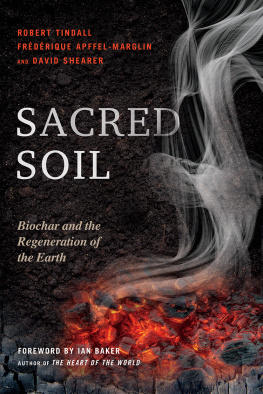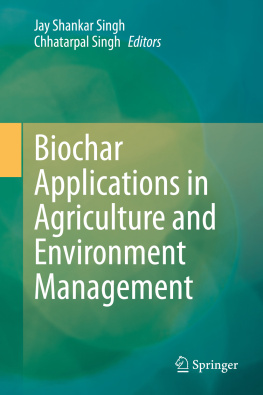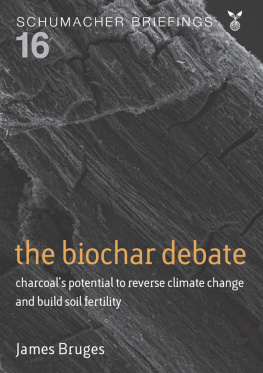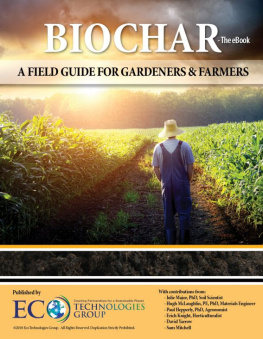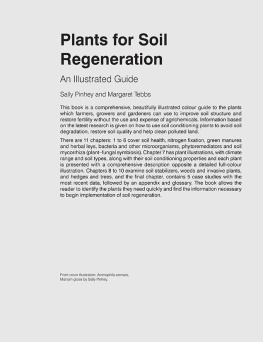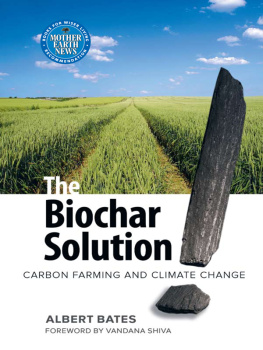
Praise for Sacred Soil
Sacred Soil is a major contribution to healing the septic split dividing spirit from matter, and culture from nature, that is poisoning all life. With soil as its exemplarat once material, biological, and sacredthis book reminds us that we are part of a greater world that is alive, intelligent, and whole.
Patrick Curry, author of Ecological Ethics
Magic flows in Sacred Soil, and realism beckons throughout the mythopoeic, historical, anthropological, and scientific perspectives on times, characters, and the fecundities of life. These authors join imaginative writing, distinctive research, and interdisciplinary engagement with environmental concern in this magnificent account of how ceramic shards, burials, and the processes of life-death make biochar soil.
John A. Grim, Forum on Religion and Ecology at Yale
Over the last decades botanists and ecologists working in the forests of the Amazon have found large but isolated expanses of terra pretablack soil, clearly of human originsshowing that indigenous peoples did not simply slash and burn and move on, but chose instead to stay put, actively enhancing the agricultural potential of the land, with charcoal for nutrient retention, and organic waste as compost. A book examining the significance of these new revelations, and indeed celebrating the potential of such indigenous technologies, has been long overdue.
Wade Davis, professor of anthropology, University of British Columbia
A superb historical, ethnographic, fictional, scientific, and applicable account of one of the wonders of humanitythe anthropogenic black earth of the Amazonthis changes our perception of pre-Columbian Amazonian societies, their knowledge, complexity, and the extent of their spiritually-imbued contribution to biodiversity. Most importantly, this work clearly indicates possible contemporary applications of Amerindian concepts and techniques to most needed environmental regeneration.
Luis Eduardo Luna, director of Wasiwaska Research Center
This groundbreaking book reveals the hidden story of the astonishing and profoundly ethical civilization of the Amazonian Indians. For millennia the indigenous peoples of the Amazon rain forest constructed a civilization of harmonious coexistence of humans, plants, animals, physical entities, and the intangible spiritual beings that inhabit the quantum world. And they did it by creating and recreating their own healthy environment. This jewel of a book is a breath of pure utopian air.
Stefano Varese, PhD, professor emeritus, University of California, Davis
Copyright 2017 by Robert Tindall, Frdrique Apffel-Marglin, PhD, David Shearer, PhD. All rights reserved. No portion of this book, except for brief review, may be reproduced, stored in a retrieval system, or transmitted in any form or by any meanselectronic, mechanical, photocopying, recording, or otherwisewithout the written permission of the publisher. For information contact North Atlantic Books.
Published by
North Atlantic Books
Berkeley, California
Cover photos Samarets/Shutterstock.com, AlenKadr/Shutterstock.com, ThomasLENNE/Shutterstock.com, Mykola Mazuryk/Shutterstock.com
Cover design by Rob Johnson
Book design by Happenstance Type-O-Rama
Printed in the United States of America
Sacred Soil: Biochar and the Regeneration of the Earth is sponsored and published by the Society for the Study of Native Arts and Sciences (dba North Atlantic Books), an educational nonprofit based in Berkeley, California, that collaborates with partners to develop cross-cultural perspectives, nurture holistic views of art, science, the humanities, and healing, and seed personal and global transformation by publishing work on the relationship of body, spirit, and nature.
North Atlantic Books publications are available through most bookstores. For further information, visit our website at www.northatlanticbooks.com or call 800-733-3000.
Library of Congress Cataloging-in-Publication Data
Names: Tindall, Robert, author.
Title: Sacred soil : biochar and the regeneration of the earth / Robert
Tindall, Frdrique Apffel-Marglin, PhD, David Shearer, PhD.
Description: Berkeley, California : North Atlantic Books, [2017] | Includes bibliographical references and index.
Identifiers: LCCN 2017002886 (print) | LCCN 2017008557 (ebook) | ISBN 9781623171186 (pbk.) | ISBN 9781623171193 (ebook)
Subjects: LCSH: Conservation of natural resourcesAmazon River Valley. | Traditional ecological knowledgeAmazon River Valley. | BiocharAmazon River Valley.
Classification: LCC S944 .T56 2017 (print) | LCC S944 (ebook) | DDC 333.720981/1dc23
LC record available at https://lccn.loc.gov/2017002886
North Atlantic Books is committed to the protection of our environment. We partner with FSC-certified printers using soy-based inks and print on recycled paper whenever possible.
Foreword
Terra preta refers to the dark, deeply fertile, humanly enhanced topsoil that pre-Columbian civilizations of the Amazon basin created to support flourishing populations intimately integrated with their natural environments, until disease and genocide in the wake of the Spanish and Portuguese conquests of the fifteenth and sixteenth centuries left only an estimated 5% of the original Amazonian peoples alive. But far beyond a eulogy for a vanished earthly paradise that archaeological evidence is only now revealing, Sacred Soil offers an inspiring, multifaceted account of how an indigenous form of soil improvement, first identified in 1870, transformed the notoriously deficient topsoil of the Amazonian rain forest into a highly productive medium with two to three times the nutrient content of the surrounding terra comum, or common soil. Just as importantly, Sacred Soil conveys the Amazonian worldview through which this fertile commingling of earth and human ingenuity arose. It also outlines the current global applicability of terra preta agriculture and the capacity of its principle ingredient, biocharthe biomass-derived charcoal that attracts nutrient-retaining fungi and microorganismsto actively restore the planets severely depleted resource base and to reduce atmospheric carbon by preventing up to 80% of greenhouse gases such as nitrous oxides and methane from escaping from the soil. Such effects reflect not only the preindustrial dispensation of indigenous populations, but also those of twentieth-century environmental visionaries, such as Aldo Leopold, who wrote in 1949 that when we see land as a community to which we belong, we may begin to use it with love and respect.
As Sacred Soil reveals, the lost civilizations of the Amazon fertilized their land and enriched their environment through a regenerative form of geoengineering that epitomizes the creative impact that humankind can have in sustaining, rather than compromising, the health of the biosphere. The very etymology of human being speaks to this vital role. The Latin name for human is homo, which derives from humus, the living organic matter that comprises what we call soil. This fundamental intimacy between our species and the ground on which we walk was invoked presciently by Mahatma Gandhi, who stated, to forget how to dig the earth and to tend the soil is to forget ourselves. The novelist Tom Robbins echoed this sentiment when he wrote that the further we separate ourselves from the dirt, the further we separate ourselves from ourselves. Alienation is a disease of the unsoiled.
Soil speaks to our most basic nature. Nutrients and chemical signals flow through an invisible underground network just as they do within our bodies. Without the organic, mineral-rich material that supports plant life, no other life can exist. Soilthe pedosphereis thus in its largest sense the inalienable source and final destination of all living things. In his 1917 Nobel Prizewinning novel,
Next page
